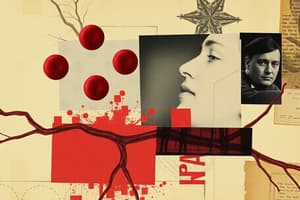Podcast
Questions and Answers
What is the primary function of hemostasis?
What is the primary function of hemostasis?
- To prevent excessive bleeding after vascular injury (correct)
- To regulate the production of blood cells
- To promote blood flow in the vascular system
- To transport oxygen throughout the body
Which of the following is NOT a component of hemostasis?
Which of the following is NOT a component of hemostasis?
- Coagulation enzymes activation
- Lymphatic system activation (correct)
- Vasoconstriction
- Platelet adhesion and aggregation
What is the role of von Willebrand Factor (vWF) in hemostasis?
What is the role of von Willebrand Factor (vWF) in hemostasis?
- Contracts the smooth muscle of blood vessels
- Facilitates platelet adhesion to the injured vessel wall (correct)
- Forms a stable fibrin clot
- Activates coagulation enzymes
Which of the following is responsible for the formation of a stable blood clot?
Which of the following is responsible for the formation of a stable blood clot?
What is the role of Factor IIa (Thrombin) in the coagulation cascade?
What is the role of Factor IIa (Thrombin) in the coagulation cascade?
Which of the following is NOT a factor activated in the intrinsic pathway of coagulation?
Which of the following is NOT a factor activated in the intrinsic pathway of coagulation?
Which of the following statements regarding platelet aggregation is CORRECT?
Which of the following statements regarding platelet aggregation is CORRECT?
Which of the following factors is activated by Tissue Factor (TF) in the extrinsic pathway?
Which of the following factors is activated by Tissue Factor (TF) in the extrinsic pathway?
Which of the following is NOT a key cellular element of hemostasis?
Which of the following is NOT a key cellular element of hemostasis?
What is the primary function of fibrin stabilizing factor (factor XIIIa)?
What is the primary function of fibrin stabilizing factor (factor XIIIa)?
During which phase of hemostasis does vasoconstriction primarily occur?
During which phase of hemostasis does vasoconstriction primarily occur?
Which of the following is NOT a component of a thrombus?
Which of the following is NOT a component of a thrombus?
What is the role of plasmin in hemostasis?
What is the role of plasmin in hemostasis?
How does vasoconstriction contribute to hemostasis?
How does vasoconstriction contribute to hemostasis?
What is the role of extravascular tissue factor (TF) in hemostasis?
What is the role of extravascular tissue factor (TF) in hemostasis?
Which of the following statements accurately describes the relationship between primary and secondary hemostasis?
Which of the following statements accurately describes the relationship between primary and secondary hemostasis?
What is the main function of the vascular intima in hemostasis?
What is the main function of the vascular intima in hemostasis?
Which of the following is a key factor in stabilizing the platelet plug during hemostasis?
Which of the following is a key factor in stabilizing the platelet plug during hemostasis?
What is the primary function of fibrin in the vascular intima?
What is the primary function of fibrin in the vascular intima?
Which layer of a blood vessel is primarily responsible for regulating blood flow?
Which layer of a blood vessel is primarily responsible for regulating blood flow?
Which of the following is NOT a role of endothelial cells?
Which of the following is NOT a role of endothelial cells?
What is the significance of the vascular adventitia?
What is the significance of the vascular adventitia?
What is the relationship between fibrinolysis and secondary hemostasis?
What is the relationship between fibrinolysis and secondary hemostasis?
Which of these statements accurately describes the vascular intima?
Which of these statements accurately describes the vascular intima?
Which of the following is NOT a characteristic of endothelial cells?
Which of the following is NOT a characteristic of endothelial cells?
How does inflammation affect vascular permeability?
How does inflammation affect vascular permeability?
How does inflammation contribute to hemostasis?
How does inflammation contribute to hemostasis?
What is the primary role of platelets in hemostasis?
What is the primary role of platelets in hemostasis?
What happens to blood flow in an intact vessel due to the presence of normal Extracellular Matrix (ECM)?
What happens to blood flow in an intact vessel due to the presence of normal Extracellular Matrix (ECM)?
Which of the following is NOT a function of the extra-vascular components (tissues surrounding blood vessels) in hemostasis?
Which of the following is NOT a function of the extra-vascular components (tissues surrounding blood vessels) in hemostasis?
What is the primary role of ionized calcium in coagulation?
What is the primary role of ionized calcium in coagulation?
How do platelets interact with fibrin to form a stable clot?
How do platelets interact with fibrin to form a stable clot?
Which of the following statements is true regarding the role of coagulation in hemostasis?
Which of the following statements is true regarding the role of coagulation in hemostasis?
What is the primary function of the barrier function of the extra-vascular tissues in hemostasis?
What is the primary function of the barrier function of the extra-vascular tissues in hemostasis?
What is the primary role of prostacyclin in the vascular system?
What is the primary role of prostacyclin in the vascular system?
Which component is NOT involved in the coagulation process?
Which component is NOT involved in the coagulation process?
What is the function of capillaries in the circulatory system?
What is the function of capillaries in the circulatory system?
What prevents blood from clotting in the absence of injury?
What prevents blood from clotting in the absence of injury?
Which describes the composition of capillaries?
Which describes the composition of capillaries?
In the context of hemostasis, hypocoagulation refers to:
In the context of hemostasis, hypocoagulation refers to:
What role do endothelial cells play in hemostasis?
What role do endothelial cells play in hemostasis?
Which vessel is associated with returning blood to the heart?
Which vessel is associated with returning blood to the heart?
What is the primary function of arteries in the vascular system?
What is the primary function of arteries in the vascular system?
Which layer of the blood vessel is composed of smooth muscle and is responsible for contraction and dilation?
Which layer of the blood vessel is composed of smooth muscle and is responsible for contraction and dilation?
What condition is characterized by an excess of fibrinolysis leading to excessive bleeding?
What condition is characterized by an excess of fibrinolysis leading to excessive bleeding?
What is a common condition related to hypercoagulable states?
What is a common condition related to hypercoagulable states?
Which type of blood vessel connects capillaries to veins?
Which type of blood vessel connects capillaries to veins?
What can lead to thrombosis in hypercoagulable states?
What can lead to thrombosis in hypercoagulable states?
What is the role of smooth muscle in blood vessels?
What is the role of smooth muscle in blood vessels?
Which statement about coagulation factors is true?
Which statement about coagulation factors is true?
Flashcards
Coagulation
Coagulation
The process that prevents excessive bleeding and forms a stable blood clot.
Hemostasis
Hemostasis
The physiological process that stops bleeding while maintaining blood flow.
Platelet Adhesion
Platelet Adhesion
The initial attachment of platelets to the site of vascular injury via GPIb and vWF.
Platelet Aggregation
Platelet Aggregation
Signup and view all the flashcards
Coagulation Enzymes Activation
Coagulation Enzymes Activation
Signup and view all the flashcards
Factor VII a
Factor VII a
Signup and view all the flashcards
Factor II a
Factor II a
Signup and view all the flashcards
Intrinsic and Extrinsic Pathways
Intrinsic and Extrinsic Pathways
Signup and view all the flashcards
Hematopoietic stem cells
Hematopoietic stem cells
Signup and view all the flashcards
Fibrinolysis
Fibrinolysis
Signup and view all the flashcards
Extravascular component
Extravascular component
Signup and view all the flashcards
Inflammation in hemostasis
Inflammation in hemostasis
Signup and view all the flashcards
Role of platelets
Role of platelets
Signup and view all the flashcards
Coagulation factors
Coagulation factors
Signup and view all the flashcards
Chemical signals in hemostasis
Chemical signals in hemostasis
Signup and view all the flashcards
Vascular Intima
Vascular Intima
Signup and view all the flashcards
Fibrin
Fibrin
Signup and view all the flashcards
Vascular Media
Vascular Media
Signup and view all the flashcards
Vascular Adventitia
Vascular Adventitia
Signup and view all the flashcards
Endothelial Cells
Endothelial Cells
Signup and view all the flashcards
Vascular Permeability
Vascular Permeability
Signup and view all the flashcards
Angiogenesis
Angiogenesis
Signup and view all the flashcards
Vasoconstriction
Vasoconstriction
Signup and view all the flashcards
Primary Hemostasis
Primary Hemostasis
Signup and view all the flashcards
Secondary Hemostasis
Secondary Hemostasis
Signup and view all the flashcards
Extravascular Tissue Factor (TF)
Extravascular Tissue Factor (TF)
Signup and view all the flashcards
Prostacyclin
Prostacyclin
Signup and view all the flashcards
Role of Blood Vessels in Hemostasis
Role of Blood Vessels in Hemostasis
Signup and view all the flashcards
Capillaries
Capillaries
Signup and view all the flashcards
Hypocoagulation
Hypocoagulation
Signup and view all the flashcards
Hypercoagulation
Hypercoagulation
Signup and view all the flashcards
Arteries
Arteries
Signup and view all the flashcards
Veins
Veins
Signup and view all the flashcards
Tunica Intima
Tunica Intima
Signup and view all the flashcards
Tunica Media
Tunica Media
Signup and view all the flashcards
Tunica Adventitia
Tunica Adventitia
Signup and view all the flashcards
Arterioles
Arterioles
Signup and view all the flashcards
Study Notes
Hematology 2: Principle of Coagulation
- Coagulation is crucial for hemostasis, preventing excessive bleeding from injured blood vessels.
- Hemostasis is a complex cascade involving vascular, cellular, and molecular components.
- Vasoconstriction: Narrowing of blood vessels to reduce blood flow.
- Platelet adhesion and aggregation: Platelets stick to each other and to the injured vessel wall, forming a temporary plug.
- Coagulation enzyme activation: A cascade of enzymatic reactions lead to thrombus (clot) formation.
- Intrinsic pathway: Initiated by factors already present in the blood.
- Extrinsic pathway: Initiated by tissue factor released from injured tissues.
- Common pathway: Both pathways converge.
- Thrombin is a key enzyme, converting fibrinogen to fibrin, which forms the stable clot.
- Plasmin dissolves the clot through fibrinolysis.
- Platelets, vascular intima, factors, and extra-vascular tissues are key components involved in the process.
- Endothelial cells secrete factors like prostacyclin to prevent unnecessary clotting.
- Balanced hemostasis is vital for maintaining proper blood flow and preventing abnormal bleeding or clotting.
Hemostasis Cellular Elements
- Vascular intima, extravascular tissue factors (factor III), blood coagulation factors, platelets, and fibrinolytic proteins are key components.
- Blood vessels have three layers: intima, media, and adventitia, each with distinct functions to regulate blood flow.
- Endothelial cells play a vital role in maintaining a balance between clotting and anti-clotting mechanisms.
- Secrete prostacyclin, nitric oxide, and other factors preventing platelet aggregation or activation.
- Platelets adhere, aggregate, and release factors crucial for clot formation.
Normal Coagulation
- Coagulation factors are balanced with fibrinolytic proteins to control blood flow and blood clotting.
Hypercoagulation
- Hypercoagulation is a state of excessive clotting, leading to thrombosis (formation of blood clots).
- This is characterized by an uncontrolled production of thrombi(a blood clot) that can occlude blood vessels, potentially leading to serious complications such as MI or stroke.
- Several conditions can contribute to hypercoagulation.
Hypo-coagulation
- Hypo-coagulation is a state of deficient clotting, leading to spontaneous bleeding.
- Conditions like hemophilia or disseminated intravascular coagulation (DIC) can lead to insufficient clot formation, resulting in prolonged bleeding.
Studying That Suits You
Use AI to generate personalized quizzes and flashcards to suit your learning preferences.




